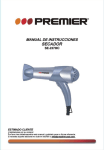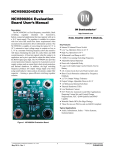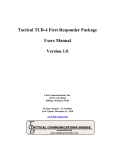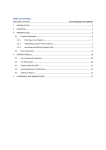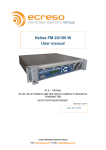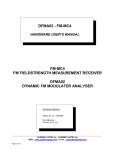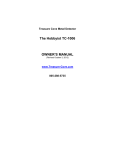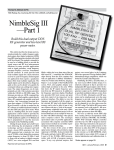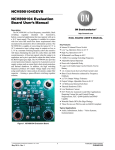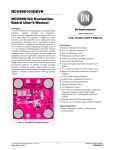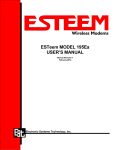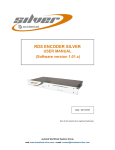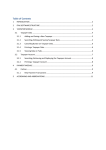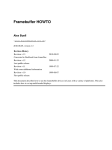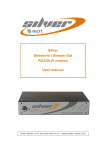Download fm receiver silver user manual
Transcript
FM RECEIVER SILVER USER MANUAL Date : 2012/10/22 Silver ® and Ecreso ® are registered trademarks. ecreso WorldCast Systems Group web: www.broadcast-silver.com - e-mail: [email protected] FM Receiver Silver - User Manual – 10/2012 TABLE OF CONTENTS 1. INTRODUCTION .......................................................................................................................................4 1.1. General information ..........................................................................................................................4 1.1.1. About Ecreso ...............................................................................................................................4 1.1.2. About the FM Receiver Silver .....................................................................................................5 1.2. Safety warning..................................................................................................................................5 2. PRODUCT PRESENTATION....................................................................................................................5 2.1. General presentation ........................................................................................................................7 2.2. List of included accessories .............................................................................................................7 2.3. General specifications ......................................................................................................................7 2.4. Front panel .....................................................................................................................................10 2.5. Rear panel ......................................................................................................................................11 3. STARTING UP ........................................................................................................................................13 3.1. Setting the reception frequency .....................................................................................................13 3.2. Checking expected output levels ...................................................................................................14 3.3. Installing the FM Receiver in racks ................................................................................................14 3.4. Setting Alarms ................................................................................................................................15 3.5. Locking the FM Receiver Silver .....................................................................................................15 3.6. Connecting and setting the IP/IO version.......................................................................................16 4. THE FRONT PANEL APPLICATION .....................................................................................................17 4.1. Working principle ............................................................................................................................17 4.2. Application presentation .................................................................................................................18 4.3. Menus .............................................................................................................................................18 5. REMOTE CONTROL AND MONITORING WITH THE GPIO BOARD ..................................................21 5.1. Introduction .....................................................................................................................................21 5.2. Description of monitoring functions ................................................................................................21 5.3. Remote monitoring function pinout ................................................................................................21 5.4. Physical representation of the GPIOs ............................................................................................22 6. THE EMBEDDED WEBSITE ..................................................................................................................23 6.1. Introduction .....................................................................................................................................23 6.2. Connecting to the embedded web site ...........................................................................................23 6.3. Viewing the Status..........................................................................................................................24 6.4. Receiver configuration....................................................................................................................25 6.5. System Configuration .....................................................................................................................27 6.5.1. Product ID .................................................................................................................................27 6.5.2. Date / Time ................................................................................................................................28 6.5.3. Users .........................................................................................................................................29 6.5.4. Network .....................................................................................................................................30 6.5.5. Support ......................................................................................................................................31 6.5.6. SNMP Agent .............................................................................................................................32 6.5.7. Notifications ...............................................................................................................................33 6.5.8. Traps .........................................................................................................................................34 6.6. About ..............................................................................................................................................35 APPENDIX A: USING A TERMINAL CONNECTION ................................................................................36 A.1. Setting up the connection .................................................................................................................36 A.2. Protocol definition .............................................................................................................................36 A.3. Serial commands list ........................................................................................................................37 Page 2 Head Office : Parc d’activites Kennedy - 20, avenue Neil Armstrong – F-33700 Bordeaux-Merignac (France) Tel +33 (0)5 57 928 928 – Fax +33 (0)5 57 928 929 – [email protected] – www.broadcast-silver.com FM Receiver Silver - User Manual – 10/2012 APPENDIX B: TRAP DESCRIPTION .........................................................................................................40 APPENDIX C: DESCRIPTION OF SNMP MONITORING PARAMETERS ...............................................42 C.1. Measured values ..............................................................................................................................42 C.2. Alarms ..............................................................................................................................................43 APPENDIX D: RDS ACCRONYMS ............................................................................................................44 APPENDIX E: FOR FURTHER INFORMATION ........................................................................................45 Page 3 Head Office : Parc d’activites Kennedy - 20, avenue Neil Armstrong – F-33700 Bordeaux-Merignac (France) Tel +33 (0)5 57 928 928 – Fax +33 (0)5 57 928 929 – [email protected] – www.broadcast-silver.com FM Receiver Silver - User Manual – 10/2012 1. INTRODUCTION 1.1. General information 1.1.1. About Ecreso Founded in 1956 near Bordeaux, ECRESO was created by radio broadcasting enthusiasts and counts today as one of the most important players on the international broadcasting stage. ECRESO offers analog and digital radio as well as digital TV transmitters (FM, DAB, DAB+, T-DMB, DVBT/H), low power transmitters, which are air-cooled, as well as high power devices either air or watercooled, receivers and retransmitters. ECRESO is part of the WorldCast Systems group of companies which combines the collective expertise & extensive product portfolio of several major broadcast brands to offer turnkey systems in all major analog and digital technologies. Other brands within the group include: Audemat who designs monitoring equipment for analog and digital radio and TV as well as an extensive range of facility remote control solutions. APT Codecs who offer reliable and cost effective broadcast codec platforms delivering high quality content over IP, T1, E1, ISDN & Leased Lines. As such, WorldCast Systems can offer complete broadcast solutions for the delivery, transmission and monitoring of broadcast content throughout the broadcast chain. The group is founded on three core values: 1) Product innovation: Audemat places a key emphasis on Research & Development and its innovative approach has been repeatedly recognized by the industry. WorldCast Systems has won awards for innovation at consecutive NAB Shows for over 10 years. 2) Customer satisfaction: Audemat is dedicated to ensuring the best quality, value and service for its customers and has achieved IS0 9001 certification. 3) Sustainable Development: Audemat is committed to sustainable development and demonstrates this commitment in several ways: it adheres to the UN Global Compact project and all new products are developed in keeping with an eco-design philosophy and built within Audemat’s low energy consumption factory. Audemat/Ecreso employs around 80 employees at headquarters in Bordeaux-Merignac, France. Audemat/Ecreso also has a subsidiary in Miami, USA that manages the North & South American markets as well as sales offices in the UK and India. An extensive network of international dealers and distributors means that the company is represented in over 45 countries throughout Europe, Middle East, Africa and Asia. Page 4 Head Office : Parc d’activites Kennedy - 20, avenue Neil Armstrong – F-33700 Bordeaux-Merignac (France) Tel +33 (0)5 57 928 928 – Fax +33 (0)5 57 928 929 – [email protected] – www.broadcast-silver.com FM Receiver Silver - User Manual – 10/2012 1.1.2. About the FM Receiver Silver The FM Receiver Silver monitoring, controlling and re-broadcasting FM receiver has been designed for the professional FM broadcasting world. This receiver’s ergonomics and performance enable it to be integrated with low, medium or high power (re-transmission) FM transmission and re-transmission equipment, a studio or a CDM (control) or into a remote-monitoring system. The FM Receiver Silver has a RS232C port and a LAN port (option) authorizing partial receiver management: remote-control, status, alarm and level return. The FM Receiver Silver is particularly adaptable to automatic transmitting and re-transmitting systems, and makes up the basis of high performance remote-monitoring equipment. Versions Two versions of the FM Receiver Silver are available: Standard version IP/IO version: it includes a GPIO board with 6 relays and 8 digital inputs and a TCP/IP board for remote configuration via a web site and SNMP management. The 8 digital inputs are reserved for future use. 1.2. Safety warning This equipment complies with international mechanical and electrical standards. To maintain this compliance, as well as to ensure proper and safe working conditions and avoid electrical shocks and fire hazards, you must comply with the following recommendations: The device should only be utilized in the conditions described in the user manual. The device is designed for industrial usage and must only be operated by qualified personnel. The device may be heavy; it must be lifted and handled with care, specifically during unpacking and set up. Electrical precautions Unplug from mains outlet before any intervention. Any maintenance, adjustment or repair must be carried out by personnel specifically trained by WorldCast Systems. Before switching on the device, make sure the nominal voltage specified on the device matches the mains nominal voltage. The device should only be operated on a stable electrical network. If the electrical network is not stable, a power conditioner, such as a UPS, must be used The device must only be used with a plug that incorporates a protective ground contact. To avoid any risk of electrocution, the protection conductor must not be cut, intentionally or accidentally, either on the device or on the power cord. High quality shielded cables are mandatory. Environmental precautions It is necessary to verify that environmental conditions comply with those recommended in the manual. Nothing must obstruct the ventilation. To avoid any electromagnetic interference, the device must only be used when it is closed, installed in a cabinet and connected to the earth as per the instructions. Page 5 Head Office : Parc d’activites Kennedy - 20, avenue Neil Armstrong – F-33700 Bordeaux-Merignac (France) Tel +33 (0)5 57 928 928 – Fax +33 (0)5 57 928 929 – [email protected] – www.broadcast-silver.com FM Receiver Silver - User Manual – 10/2012 The device should not be exposed to dripping or splashing and no objects filled with liquids, such as coffee cups, should be placed on the equipment. Connectors may be hot on high power units. Precautions regarding the lithium battery This device includes a lithium battery. If the battery is not correctly replaced, there is a risk of explosion. Only replace it with a battery of the same type. Contact us before attempting to use another type Do not puncture the battery Do not throw the battery in fire Do not immerse the battery in water Do not throw away the used battery, recycle it instead. You may send it back to us if needed. If these precautions are not followed, the guarantee will be void. Page 6 Head Office : Parc d’activites Kennedy - 20, avenue Neil Armstrong – F-33700 Bordeaux-Merignac (France) Tel +33 (0)5 57 928 928 – Fax +33 (0)5 57 928 929 – [email protected] – www.broadcast-silver.com FM Receiver Silver - User Manual – 10/2012 2. PRODUCT PRESENTATION 2.1. General presentation The FM Receiver Silver is a rackable 19" wide and 1 Unit high, making it easy to integrate into all types of standard cabinets. Reliability and simple operation have been the main concern while designing it. All the functions can be set using only using the front panel LCD screen and its control keypad. A series of 6 red indicator LEDs allow the user to quickly view the status of alarms. Operating reliability is increased thanks to the use of protected, large size components. Maximum operating security is made possible by locking the data acquisition command by software and by using modern back-up components, excluding all external energy (neither batteries nor accumulators). Finally, mechanical and electrical procedures have been developed to ensure maximum safety during any operations in an electrically active environment (CEM). Generally speaking, the FM Receiver Silver complies with the latest European specifications (mains supply voltage, insulation, etc...). 2.2. List of included accessories Check that all elements are present in the box: Power supply cable 1 box including the documentation CD, a quick start notice and a quality control form. 2.3. General specifications Main characteristics External dimensions (W x H x D mm) 483 (19’’) x 1U x 379 Weight about 3.4 kg Power supply voltage 88 V – 264 V AC Power supply frequency 47 Hz - 63 Hz Power consumption about 45 VA Temperature Optimal performance temperatures Guaranteed working temperatures Storage Humidity +5°C - +45°C 0°C - +50°C -20°C - +70°C 10-95% non-condensing relative humidity Page 7 Head Office : Parc d’activites Kennedy - 20, avenue Neil Armstrong – F-33700 Bordeaux-Merignac (France) Tel +33 (0)5 57 928 928 – Fax +33 (0)5 57 928 929 – [email protected] – www.broadcast-silver.com FM Receiver Silver - User Manual – 10/2012 RF Section Tuning frequencies 87.5 to 108.00 MHz Programming step User defined at 10 kHz or 100 kHz (default: 100 kHz) Frequency accuracy 10 ppm at 25°C RF connector and impedance 2 x BNC / 50 Ω Max input RF level 120 dBµV (+13 dBm) RF Attenuation 0 / 40 dB IF selectivity Wide / Middle / Narrow Static selectivity Wide @ -3 dB Wide @ -60 dB Middle @ -3 dB Middle @ -60 dB Narrow @ -3 dB Narrow @ -60 dB Sensitivity 350 kHz 500 kHz 120 kHz 400 kHz 80 kHz 300 kHz S/N 60 dB RMS 20~23 kHz (mono) AF output < 40 dBµV MPX output < 50 dBµV MPX Signal / Noise, 1 kHz AF at 75 kHz excursion: RMS Weighted QP CCIR 62dB 50 dB Separation < -33 dB @ 1 kHz Distortion 0.1% @ 1 kHz (typical) Bandwidth 40 Hz~15 kHz, ± 0.4 dB Stereo decoder Signal / Noise , 1 kHz AF at 75 kHz excursion: RMS Weighted QP CCIR 65 dB 53 dB Separation < -40 dB @ 1 kHz Distortion 0.2% @ 1 kHz (typical) Bandwidth (48 ksps) 40 Hz~15 kHz, ± 0.85 dB 19 kHz suppression (32 ksps) > 50 dB Page 8 Head Office : Parc d’activites Kennedy - 20, avenue Neil Armstrong – F-33700 Bordeaux-Merignac (France) Tel +33 (0)5 57 928 928 – Fax +33 (0)5 57 928 929 – [email protected] – www.broadcast-silver.com FM Receiver Silver - User Manual – 10/2012 Measurements Receiver modulation level Front panel LED meters (L&R) MPX deviation level from 0 to 99 kHz (Step 1 kHz) RF level from 0 to 75 dBµV (Step 1 dBµV) RDS Presence / absence PILOT Presence / absence RDS data PI, PS, AF, DI, TP, TA, PTY, MS, CT 10% 10% Outputs AF type: XLR levels: -31 to +15 dB (1.5 dB) * AES type: XLR, complete EIAJ CP1201, IEC-60958, AES3 Audio Sample rate: 32 ksps MPX type: BNC levels: 0, +6, +12 dB (+ manual adjustment from +2 dB) Phones 6.35 mm stereo jack > 50 Ω Other connectors RS-232 Complies to EIA RS232C standard USB Reserved for future use * Be aware that an audio level greater than +6 dB will lead to saturation of the signal. Page 9 Head Office : Parc d’activites Kennedy - 20, avenue Neil Armstrong – F-33700 Bordeaux-Merignac (France) Tel +33 (0)5 57 928 928 – Fax +33 (0)5 57 928 929 – [email protected] – www.broadcast-silver.com to FM Receiver Silver - User Manual – 10/2012 2.4. Front panel LCD screen Audio output Alarm indicator LEDs Receiver modulation indicator LEDs Control keypad When an alarm is on, the corresponding LED will turn red. The following events can trigger alarms: The RF level is lesser than the minimum threshold (RF-) The RF level is greater than the maximum threshold (RF+) The MPX level is lesser than the minimum threshold (MPX-) The MPX level is greater than the maximum threshold (MPX+) The pilot signal is not detected (Stereo) The RDS signal is not detected (RDS) On the IP/IO version, if all alarms blink, it means the unit switched to the backup configuration. The peak meter shows the modulation level. To reset your FM Receiver Silver to factory settings, turn it off, then keep the Right and Left arrow function keys pressed while turning it on. When the FM Receiver Silver is turned off, the state of the alarms is not memorized. Page 10 Head Office : Parc d’activites Kennedy - 20, avenue Neil Armstrong – F-33700 Bordeaux-Merignac (France) Tel +33 (0)5 57 928 928 – Fax +33 (0)5 57 928 929 – [email protected] – www.broadcast-silver.com FM Receiver Silver - User Manual – 10/2012 2.5. Rear panel RF1 and RF2 inputs R + L AF outputs MPX1, MPX2 outputs and their adjustment pots Relay outputs (IP/IO version) AES output Serial port Ethernet port (IP/IO version) Mains Ground The MPX outputs: Default setting is +12 dBu. They can be set by jumper, see procedure below. The output level can be fine-tuned with a tuning screwdriver: turn the adjustment pot clockwise to decrease and counterclockwise to increase the level. The adjustment range is from - to +2 dB. The AF outputs: Default setting is 12 dBu. They can be set by jumper, see procedure below. The AES output: It is set to 32 ksps, nominal -14 dBFS. The speed can be modified using a serial/Telnet command (see APPENDIX A:). Additional ports are reserved for future use. Page 11 Head Office : Parc d’activites Kennedy - 20, avenue Neil Armstrong – F-33700 Bordeaux-Merignac (France) Tel +33 (0)5 57 928 928 – Fax +33 (0)5 57 928 929 – [email protected] – www.broadcast-silver.com FM Receiver Silver - User Manual – 10/2012 Before setting the jumpers, make sure that all cables are disconnected. Remove the 8 screws securing the cover. R output L output MPX2 MPX1 All jumpers on this board are set at 12 dB. FM Receiver Silver front panel For each output, set the jumpers according to your needs and as indicated on the printed circuit. Once set, put the cover back in place and screw all 8 screws. Page 12 Head Office : Parc d’activites Kennedy - 20, avenue Neil Armstrong – F-33700 Bordeaux-Merignac (France) Tel +33 (0)5 57 928 928 – Fax +33 (0)5 57 928 929 – [email protected] – www.broadcast-silver.com 12 dB 6 dB 0 dB FM Receiver Silver - User Manual – 10/2012 3. STARTING UP 3.1. Setting the reception frequency Connect the reception antenna to the RF1 connector and connect the FM Receiver Silver to the mains. See connection diagram section 2.5. Turn on the FM Receiver Silver using the switch on the rear panel. Now use the front screen application to set your FM Receiver Silver A set of keys allow you to browse through the menus. Navigate from one screen or one function to the next Save current settings Lock LED: when on, parameters cannot be modified on the front panel Adjust values Freq 098.50MHz Level 035dBµ This is the 1st screen you will see. When the cursor blinks on the frequency, use the Up and Down arrow keys to find the frequency you need. The frequency is already set. Control the RF level displayed on the same screen. This value includes the effects of attenuation. If the RF level is over 100 dBµV, we strongly advise you to set the internal RF attenuator. Mode STwid Ant 1 ATT 0dB Press the Function arrow keys until you reach this screen, and keep using the Function keys until the ATT value is selected (“0dB” is highlighted). Press the Value keys to adjust the attenuation to 40 dB. Use the Function keys to go back to the main RF screen: the level value is now attenuated. Check the front panel LED peak meter: if the signal reception is correct, you will see no red light. A red light could indicate an issue with the reception frequency. Conf Set1 Recall / Save val- val+ Press the “Enter” key then the Up arrow key to save the settings you just modified. Page 13 Head Office : Parc d’activites Kennedy - 20, avenue Neil Armstrong – F-33700 Bordeaux-Merignac (France) Tel +33 (0)5 57 928 928 – Fax +33 (0)5 57 928 929 – [email protected] – www.broadcast-silver.com FM Receiver Silver - User Manual – 10/2012 3.2. Checking expected output levels Default output levels are +12 dBu for MPX1, MPX2 and AF outputs. They can be set by internal jumpers at +12 dBu, +6 dBu or 0 dBu. ! See section 2.5 if you need to set the jumpers. MPX BNC output fine tuning: See connection diagram section 2.5. Connect cable from the MPX output of the FM Receiver Silver to the transmitter’s MPX input. Adjust MPX1 and/or MPX2 levels with the rear panel potentiometers using a tuning screwdriver. Turn clockwise to decrease and counterclockwise to increase the MPX output level. AF XLR outputs fine tuning: Connect cables from the AF outputs of the FM Receiver Silver to the transmitter’s AF inputs. Adjust the AF outputs levels (AfLev) using the front side application. Press the Function arrow keys until you reach this screen, and keep using the arrow keys until the AfLev value is selected (“0dB” is highlighted). Press the Value keys to fine tune the level; we recommend you do not exceed + 6 dB for this parameter. Conf Set1 Recall / Save val- val+ Loc N AfLev 0dB HeadP 92% Press the “Enter” key then the Up arrow key to save the settings you just modified. Turn off the FM Receiver Silver. 3.3. Installing the FM Receiver in racks See connection diagram section 2.5. Connect the chassis ground to the rack ground. Connect cables (MPX BNC and/or AF output XLR) to the transmitter’s input. Connect the FM Receiver Silver to the mains and turn on the unit. Adjust the complete retransmission chain for expected total signal deviation (see previous section if you need to fine tune) Conf Set1 Recall / Save val- val+ If you adjusted the AF level value, press the “Enter” key then the Up arrow key to save the settings you just modified. Page 14 Head Office : Parc d’activites Kennedy - 20, avenue Neil Armstrong – F-33700 Bordeaux-Merignac (France) Tel +33 (0)5 57 928 928 – Fax +33 (0)5 57 928 929 – [email protected] – www.broadcast-silver.com FM Receiver Silver - User Manual – 10/2012 3.4. Setting Alarms RF 65 En Y Mi 30 Ma 120 Del 127 Press the Function arrow keys until you reach the RF alarm screen, and keep using the Function keys until the desired parameter is selected (corresponding value is highlighted). Press the Value keys to adjust: the minimum threshold (MI, in dBµV), the maximum threshold (MA, in dBµV) and the alarm triggering delay (Del, in s). Note that the RF level is given after the attenuation (as set in section 2). This is read-only value. Enable monitoring the RF signal by setting the En parameter to “Yes”. Conf Set1 Recall / Save val- val+ Press the “Enter” key then the Up arrow key to save the settings you just modified. 3.5. Locking the FM Receiver Silver Once your FM Receiver Silver is set, lock it to avoid unintentional changes: Press the Function arrow keys until you reach this screen and the Loc value is selected (“N” is highlighted). Press the Value keys to switch the setting to “Y”. Conf Set1 Recall / Save val- val+ Loc N AfLev 0dB HeadP 92% Press the “Enter” key then the Up arrow key to save the settings you just modified. The front panel Lock LED will be lit when the FM Receiver Silver is locked. Page 15 Head Office : Parc d’activites Kennedy - 20, avenue Neil Armstrong – F-33700 Bordeaux-Merignac (France) Tel +33 (0)5 57 928 928 – Fax +33 (0)5 57 928 929 – [email protected] – www.broadcast-silver.com FM Receiver Silver - User Manual – 10/2012 3.6. Connecting and setting the IP/IO version Press the Function arrow keys until you reach this screen. Press the Value keys to modify the IP address. Device IP addr 172.017.002.172 Press the Function arrow keys until you reach this screen. Press the Value keys to modify the Netmask. Device Netmask 255.255.000.000 Connect the network cable (B) between the FM Receiver Silver’s Ethernet port and a PC. See connection diagram on the last page of this notice. You will need to set an address on the PC in the same range as the new IP address, so it is compatible with the IP address in the FM Receiver Silver. For this, if using Windows 2000 or Windows XP, go to: Control panel/Network connections/ Local Area Connection / Properties Click on Internet Protocol (TCP/IP) in the scroll-down menu then on “Properties”. Add the IP address and the sub-network mask. With Windows Vista or 7, go to: Control panel / Network and Internet / Network and Sharing Center. Click on “View Status” for your local area connection, and on Properties Click on Internet Protocol 4 then on Properties. Add the IP address and the sub-net mask. Open a Web Browser (Google Chrome, Mozilla Firefox, Internet Explorer…) and enter the new IP address in the address bar. The default login and password are “Admin” and “admin”. Click the ‘System’ button and display the ‘Network’ page. Modify the gateway. Click the ‘Save’ button. You will be able to view and modify all parameters using this web interface. Page 16 Head Office : Parc d’activites Kennedy - 20, avenue Neil Armstrong – F-33700 Bordeaux-Merignac (France) Tel +33 (0)5 57 928 928 – Fax +33 (0)5 57 928 929 – [email protected] – www.broadcast-silver.com FM Receiver Silver - User Manual – 10/2012 4. THE FRONT PANEL APPLICATION 4.1. Working principle A set of keys allow you to browse through the menus. Navigate from one screen or one function to the next Save current settings Lock LED: when on, parameters cannot be modified on the front panel Adjust values When a parameter can be adjusted, the cursor blinks on this parameter. Example: SteRx M FreqStep 100kHz On this screen, the reception is in Mono, this cannot be modified The frequency step however can be set to either 10 or 100 kHz, the cursor is on the step. Two different types of values can be adjusted: Text values: the Up and Down arrows scroll through a preset list Number values: the Up and Down arrows increase or decrease the value; keep the key pressed to increment faster. ! Please note that all changes are applicable immediately but need to be saved so they can be retrieved after the FM Receiver Silver is turned off and on again. To save in the current preset: press the “Enter” key and then the Up arrow key. See the last screen in the next section for more details. Page 17 Head Office : Parc d’activites Kennedy - 20, avenue Neil Armstrong – F-33700 Bordeaux-Merignac (France) Tel +33 (0)5 57 928 928 – Fax +33 (0)5 57 928 929 – [email protected] – www.broadcast-silver.com FM Receiver Silver - User Manual – 10/2012 4.2. Application presentation Using the front panel application, you will be able to view the following information: Frequency (screen 1) Level (screen 1) Mode, stereo or mono (screen 2) RDS information: o PI, PS (screen 6), o TP/TA, MS, DI, PTY (screen 7), o AF list (screen 8) o UTC time (screen 9) You will also be able to set the following parameters: Frequency (screen 1) Frequency step (screen 2) RF alarm (screen 3) MPX alarm (screen 4) RDS alarm (screens 5 and 4) Stereo alarm (screens 5 and 4) IF filter and receiving mode (screen 10) Antenna selection (screen 10) AF attenuation (screen 10) Deemphasis (screen 11) RF backup (screen 11) Front panel lock (screen 12) AF output level (screen 12) Headphone output level (screen 12) IP address and Netmask (screens 13 and 14) Screen numbers refer to numbers in the next section. 4.3. Menus 1 Freq 098.50MHz Level 035dBµ The frequency can be modified: when this screen is first displayed, the cursor blink on the set frequency. Use the Up and Down arrows to adjust the frequency, starting with the last digit. The level (in dBµV) is of course read-only. This level is given after the attenuation selected screen 10. 2 SteRx M FreqStep 100kHz SteRx: Indicates if the current station is in mono (M) or stereo (S) (read-only value). FreqStep: Select the frequency step, 10 or 100 kHz. Page 18 Head Office : Parc d’activites Kennedy - 20, avenue Neil Armstrong – F-33700 Bordeaux-Merignac (France) Tel +33 (0)5 57 928 928 – Fax +33 (0)5 57 928 929 – [email protected] – www.broadcast-silver.com FM Receiver Silver - User Manual – 10/2012 3 RF 35 255 En Y Mi 30 Ma 120 Del 127 RF: RF level measured after attenuation (in dBµV). En: Select yes (Y) or no (N) to enable or disable RF level monitoring. Default value: N Mi: Set the minimum threshold in dBµV for the RF level. If the level is less than this threshold, it will trigger the RF- alarm. Default value: 0 Ma: Set the maximum threshold in dBµV for the RF level. If the level is greater than this threshold, it will trigger the RF+ alarm. Default value: 127 Del: Set the delay in seconds before the alarm is triggered or turned off. Default value: 255 4 Mp 62 255 En Y Mi 30 Ma 120 Del 127 Mp: MPX level measured after attenuation (in kHz). En: Select yes (Y) or no (N) to enable or disable MPX level monitoring. Default value: N Mi: Set the minimum threshold in kHz deviation for the MPX level. If the level is less than this threshold, it will trigger the MPX- alarm. Default value: 0 Ma: Set the maximum threshold in kHz deviation for the MPX level. If the level is greater than this threshold, it will trigger the MPX+ alarm. Default value: 127 Del: Set the delay in seconds before the alarm is triggered or turned off. This delay applies to the MPX alarms, but also to the RDS and to the stereo alarms. Default value: 255 5 RDS Y Ste Y RstAlm N RDS: Select yes (Y) or no (N) to enable or disable RDS presence monitoring. Default value: N Ste: Select yes (Y) or no (N) to enable or disable stereo monitoring. Default value: N RstAlm: Select yes (Y) or no (N) to reset all current alarms. The alarms are immediately reset and the parameter is automatically set back to no. Default value: N 6 7 RDS Yes PI PS CC03 KPOP MyStation Tp/Ta 0 0 MS M. 8 01 9 13:22 DI 01 RDS: Indicates if RDS is present. This screen also gives the PI and the PS decoded from the received station. PTY 00 AF List = 101.60MHz RDS UTC +02 This screen shows if the TP and TA are enabled (1) or not (0), if the M/S parameter is set to music (M) or speech (S), the DI (Decoder Identification) and the PTY If alternative frequencies exist, the 1st AF will be displayed; use the Up and Down arrow keys to scroll through the whole AF list (method A only). The AF list is not available for AM frequencies. This screen shows the RDS UTC time received 1/2Hrs Page 19 Head Office : Parc d’activites Kennedy - 20, avenue Neil Armstrong – F-33700 Bordeaux-Merignac (France) Tel +33 (0)5 57 928 928 – Fax +33 (0)5 57 928 929 – [email protected] – www.broadcast-silver.com FM Receiver Silver - User Manual – 10/2012 10 Mode STwid Ant 1 ATT 0dB Mode: 6 preset profiles are available, each with its set of IF filters: Stereo Wide (STwid), Stereo Middle (STmid), Stereo Narrow (STnar), Mono Wide (MOwid), Mono Middle (MOmid), Mono Narrow (MOnar). Default value: STwid Ant: Set to 1 or 2 depending on whether the RF1 or RF2 input is used. 11 12 Deemph 50µs Loc N RfBackup No AfLev 0dB HeadP 92% ATT: Set the attenuation to 0 or 40 dB. The 40 dB attenuation is useful when the RF level at the antenna is greater than 100 dBµV; such a level can indeed lead to disturbances in the receiver’s working process. Default value: 0. Deemph: Set the pre-emphasis to 50 or 75 μs depending on your country (50 μs in Europe, 75 μs in the USA). RfBackup: with the standard version; if enabled, the unit will automatically switch to the other RF input when an RF alarm is triggered on the current input. If RF alarms are present on both inputs, the unit will switch back and forth between RF1 IN and RF2 IN until the alarm disappears on one of the inputs. With the IO/IP version, see section 6.4. Loc: Select yes (Y) or no (N) to lock the front screen or not. We recommend you lock it after your receiver is set. Default value: N AfLev: Set the level for the AF outputs. Default value: 0 dB + amplification set by jumpers (see section 2.5). HeadP: Set the level for the headphone output. Default value: 92% 13 14 15 Device IP addr 192.168.020.030 Device Netmask 255.255.000.000 Conf Set1 Recall / Save val- val+ On this screen (only available with the IP/IO version), view and modify the IP address of the FM Receiver Silver. The IP address is not associated with a specific configuration. On this screen (only available with the IP/IO version), view and modify the IP address of the FM Receiver Silver. The Netmask is not associated with a specific configuration. Save! You should use the save often while setting you FM Receiver Silver: Simply press Enter to get to it. 10 configurations are available (Set0 through Set9). Once the desired configuration is selected, press the Right arrow key, the cursor will be under the Recall/Save function: press the Up arrow key to save. The Set9 configuration can be used as backup configuration with the IO/IP version (see section 6.4). When you wish to recall a configuration, select it, press the Right arrow key and press the Down arrow key to recall. All the parameters that are configurable with the front panel application are saved in presets. Page 20 Head Office : Parc d’activites Kennedy - 20, avenue Neil Armstrong – F-33700 Bordeaux-Merignac (France) Tel +33 (0)5 57 928 928 – Fax +33 (0)5 57 928 929 – [email protected] – www.broadcast-silver.com FM Receiver Silver - User Manual – 10/2012 5. REMOTE CONTROL AND MONITORING WITH THE GPIO BOARD 5.1. Introduction This function is available with the IP/IO version when the GPIO board is installed on the receiver. 5.2. Description of monitoring functions Outputs are relays that include a normally closed or normally open contact. When an event occurs in the unit, the corresponding relay is activated. Seven monitoring functions are associated with relays: RF-: RF level is lesser than the minimum threshold RF+: RF level is greater than the maximum threshold MPX-: MPX level is lesser than the minimum threshold MPX+: MPX level is greater than the maximum threshold Stereo: Pilot signal is not detected * RDS: RDS signal is not detected Power on: receiver is on * * The 2 events Stereo and Power On use the same relay; therefore they cannot be monitored at the same time. Enable/disable stereo monitoring using the front panel application or the embedded web site to disable/enable power monitoring. 5.3. Remote monitoring function pinout Event Relay number Pin-out RF- REL1 1-14 RF+ REL2 2-15 MPX- REL3 3-16 MPX+ REL4 4-17 Stereo * REL5 - NO 5-6 Power on * REL5 - NC 18-6 RDS REL6 7-20 Example: when an RF+ alarm occurs, it triggers a dry contact between pin 2 and pin 15 of the DB25 connector. Page 21 Head Office : Parc d’activites Kennedy - 20, avenue Neil Armstrong – F-33700 Bordeaux-Merignac (France) Tel +33 (0)5 57 928 928 – Fax +33 (0)5 57 928 929 – [email protected] – www.broadcast-silver.com FM Receiver Silver - User Manual – 10/2012 DB25 FEMALE 5.4. Physical representation of the GPIOs Reserved for future use 12 V floating power supply TC_COMMON Page 22 Head Office : Parc d’activites Kennedy - 20, avenue Neil Armstrong – F-33700 Bordeaux-Merignac (France) Tel +33 (0)5 57 928 928 – Fax +33 (0)5 57 928 929 – [email protected] – www.broadcast-silver.com FM Receiver Silver - User Manual – 10/2012 6. THE EMBEDDED WEBSITE 6.1. Introduction This function is available with the IP/IO version when the TCP/IP board is installed on the receiver. 6.2. Connecting to the embedded web site For remote access, connect to the transmitter’s embedded web site. Simply open a web browser (Google Chrome, Mozilla Firefox …) and enter the transmitter’s IP address in the address bar (default: 172.17.2.172). Though the web application is compatible with most browsers, performances vary greatly from on browser to another. For this reason, we recommend you use Google Chrome or install the Chrome Frame plug-in for Microsoft Internet Explorer Select the language if necessary. Enter the user name and password: Two user levels are available: Administrator (Admin / admin by default). The administrator has full rights Guest (Guest / guest by default). The guest has read-only access to all pages except the user management page. Check the box to save connection information. This process is managed by the web browser cookies; login and passwords are saved for 15 days. The tool bar on top of the page enables access to all pages of the site: the user can view the status, access receiver configuration and system configuration. Data can be both viewed and modified. The indicator on the right enables all connected users to know about current notifications: Page 23 Head Office : Parc d’activites Kennedy - 20, avenue Neil Armstrong – F-33700 Bordeaux-Merignac (France) Tel +33 (0)5 57 928 928 – Fax +33 (0)5 57 928 929 – [email protected] – www.broadcast-silver.com FM Receiver Silver - User Manual – 10/2012 No current notification A notification has been sent A notification has been processed 6.3. Viewing the Status This page displays the main parameters of the transmitter (read-only). LEDs give the status of the alarms: No alarm Alarm Unknown status, or element not monitored All parameters are described in section 4.3. Page 24 Head Office : Parc d’activites Kennedy - 20, avenue Neil Armstrong – F-33700 Bordeaux-Merignac (France) Tel +33 (0)5 57 928 928 – Fax +33 (0)5 57 928 929 – [email protected] – www.broadcast-silver.com FM Receiver Silver - User Manual – 10/2012 6.4. Receiver configuration This section shows the general receiver configuration and the current preset configuration in the “Main configuration” page. The location can be used to describe the site or the associated transmitter. This information is sent with the SNMP trap and helps identify the unit. The configuration number is the number of the current configuration. Check the “Lock keys” box to prevent changes from the front panel application. With the ‘Reset Alarms’ button, reset all current alarms. Page 25 Head Office : Parc d’activites Kennedy - 20, avenue Neil Armstrong – F-33700 Bordeaux-Merignac (France) Tel +33 (0)5 57 928 928 – Fax +33 (0)5 57 928 929 – [email protected] – www.broadcast-silver.com FM Receiver Silver - User Manual – 10/2012 And the details for each preset configuration. All parameters are described in section 4.3. Is RF backup is enabled on the current configuration, the unit will automatically switch to configuration 9 (different input and/or frequency) when an RF or MPX alarm occurs. Configuration 9 will remain active for 30 minutes. When RF backup is enabled on the main configuration, we recommend to disable RF and MPX monitoring on configuration 9 so that in case of error on the backup signal the receiver does not switch back and forth between both configurations. In case of alarm on the main configuration, the whole system will be in alarm (lit LEDs, SNMP traps, activated relays…); however, as soon as the receiver switches to the backup configuration, the situation becomes ‘normal’ again and no notification should be sent for 30 minutes. Before exiting the page (main or configuration 0-9), click the Save button to lock in your changes if you have updated the configuration: changes are not immediate as they are with the front panel. While working with the web site, to avoid modifications from the front panel, think about checking the ‘Lock keys’ box of the ‘Main configuration page’. Page 26 Head Office : Parc d’activites Kennedy - 20, avenue Neil Armstrong – F-33700 Bordeaux-Merignac (France) Tel +33 (0)5 57 928 928 – Fax +33 (0)5 57 928 929 – [email protected] – www.broadcast-silver.com FM Receiver Silver - User Manual – 10/2012 6.5. System Configuration In these pages, set parameters directly link to the TCP/IP board: web site, network, SNMP… Click the Save button configuration). 6.5.1. to lock in your changes (this is true for every page of the system Product ID General information regarding the product: name, serial number, versions… Use the product name and product description to adequately and uniquely describe your unit. They are useful in a network environment to identify it. Specifically, these values are sent with SNMP traps. Page 27 Head Office : Parc d’activites Kennedy - 20, avenue Neil Armstrong – F-33700 Bordeaux-Merignac (France) Tel +33 (0)5 57 928 928 – Fax +33 (0)5 57 928 929 – [email protected] – www.broadcast-silver.com FM Receiver Silver - User Manual – 10/2012 6.5.2. Date / Time Set system date: the user may update both date (year/month/day) and time (hour/minute/second). Set system time zone: The user selects the geographical zone from the list. Important to have this set correctly when using an NTP server. Set the time zone first! Changes in the time zone affect the time that is displayed in the system time window, so setting the zone first will eliminate the need to set the system time twice! U U Page 28 Head Office : Parc d’activites Kennedy - 20, avenue Neil Armstrong – F-33700 Bordeaux-Merignac (France) Tel +33 (0)5 57 928 928 – Fax +33 (0)5 57 928 929 – [email protected] – www.broadcast-silver.com FM Receiver Silver - User Manual – 10/2012 6.5.3. Users This is where web site connection settings can be modified. This page is only visible to administrators. Two web and software accounts are available: Administrator (Admin / admin by default). The administrator has full rights Guest (Guest / guest by default). The guest has read-only access to all pages except the user management page. The guest can download logs. Two FTP accounts are available: Administrator (Admin / admin by default). The administrator has full rights Update manager (update / maj by default). This account is only used for software updates. You may change login names but make sure each is unique! Only use alphanumerical characters for user names and passwords. Page 29 Head Office : Parc d’activites Kennedy - 20, avenue Neil Armstrong – F-33700 Bordeaux-Merignac (France) Tel +33 (0)5 57 928 928 – Fax +33 (0)5 57 928 929 – [email protected] – www.broadcast-silver.com FM Receiver Silver - User Manual – 10/2012 6.5.4. Network IP Configuration: Static Ethernet configuration Set the parameters for the network interface. DNS Servers: DNS configuration. Mandatory if before using DNS addresses on other configuration pages. Page 30 Head Office : Parc d’activites Kennedy - 20, avenue Neil Armstrong – F-33700 Bordeaux-Merignac (France) Tel +33 (0)5 57 928 928 – Fax +33 (0)5 57 928 929 – [email protected] – www.broadcast-silver.com FM Receiver Silver - User Manual – 10/2012 6.5.5. Support With the ‘Reboot’ button, restart your FM Receiver Silver remotely. Page 31 Head Office : Parc d’activites Kennedy - 20, avenue Neil Armstrong – F-33700 Bordeaux-Merignac (France) Tel +33 (0)5 57 928 928 – Fax +33 (0)5 57 928 929 – [email protected] – www.broadcast-silver.com FM Receiver Silver - User Manual – 10/2012 6.5.6. SNMP Agent SNMP configuration The equipment enables multiple addresses to be configured for SNMP notifications. However, only the Main Manager has the authority to acknowledge notifications. With “INFORMS” messages, automatic answers from secondary managers are ignored by the unit. MIB: to download the MIB right click on the link and select “Save link as” SNMP Traps configuration SNMP Notification Type / Trap Community / System Description: trap settings Life Sign Trap / Minutes between Life Signs: sends life signs every X minutes. This trap makes it possible to check that the unit is connected to the network. Trap sending test: enables the user to carry out a test according to the trap settings. 6.5.6.1 Supported SNMP versions The unit implements an SNMP agent conforming to SNMPv1 and SNMPv2c versions. GET and SET commands are supported, as well as GETBULK in SNMPv2c. Notifications can be transmitted in TRAP V1 or V2c form or with an INFORM V2c type. 6.5.6.2 Notification mode To make sure traps are received by the main recipient, the unit offers 2 methods. With both methods, traps are sent until they are acknowledged. Page 32 Head Office : Parc d’activites Kennedy - 20, avenue Neil Armstrong – F-33700 Bordeaux-Merignac (France) Tel +33 (0)5 57 928 928 – Fax +33 (0)5 57 928 929 – [email protected] – www.broadcast-silver.com FM Receiver Silver - User Manual – 10/2012 Automatic acknowledgement for sending with INFORM. These notifications are only available with the version 2c of the protocol. This protocol checks that the manager sends the notification to the transmitter. This process is simple and reliable, no specific configuration is required for the manager. Manual acknowledgement for Traps V1 and Traps V2c. A specific OID (“alarmPendingAlarmsalarmAck”) is extracted and its variables are sent with the trap. The manager must then execute a SET command. This method is more complex but is the only one that can work with the version 1 of the protocol. The acknowledgment mode (Trap V1, Trap V2c or Inform) is identical for all alarms. See the next section “Notifications” for additional settings. With “SNMPv2c traps” notifications, it not possible to acknowledge traps. In the same way, traps which do not require acknowledgment cannot be sent with the “Inform SNMPv2c” format, even when this format is selected. This is the case with the ‘test’ trap as well as with equipment information traps such as the ‘Equipment On’ trap. 6.5.7. Notifications SNMP Actions The user may replay traps that have not been acknowledged yet. The user may also delete pending traps that have not been acknowledged yet. Page 33 Head Office : Parc d’activites Kennedy - 20, avenue Neil Armstrong – F-33700 Bordeaux-Merignac (France) Tel +33 (0)5 57 928 928 – Fax +33 (0)5 57 928 929 – [email protected] – www.broadcast-silver.com FM Receiver Silver - User Manual – 10/2012 6.5.8. Traps Click the arrow next to the trap name to display its parameters. To enable the trap, check "Enabled". Set the mode: Resend until acknowledgement: the trap is regularly sent until acknowledgement. Send and forget: the trap is sent once, no follow-up is expected. If “Resend until acknowledgement” is selected, set the time to wait for acknowledgement before resending the trap (Ack timeout) and the maximum number of times the trap will be resent (Max retries). Set the priority; this information which is sent with the traps can be used by an SNMP Manager as filter criteria for instance. No trap is sent when switching automatically from one RF input to the other. The RfLow and RfHigh traps indicate a switch has occurred. Page 34 Head Office : Parc d’activites Kennedy - 20, avenue Neil Armstrong – F-33700 Bordeaux-Merignac (France) Tel +33 (0)5 57 928 928 – Fax +33 (0)5 57 928 929 – [email protected] – www.broadcast-silver.com FM Receiver Silver - User Manual – 10/2012 6.6. About This window displays information regarding the web application Page 35 Head Office : Parc d’activites Kennedy - 20, avenue Neil Armstrong – F-33700 Bordeaux-Merignac (France) Tel +33 (0)5 57 928 928 – Fax +33 (0)5 57 928 929 – [email protected] – www.broadcast-silver.com FM Receiver Silver - User Manual – 10/2012 APPENDIX A: USING A TERMINAL CONNECTION A.1. Setting up the connection Use the COM1 RS232 port. The FM Receiver Silver RS232 protocol is ASCII oriented, this means it can be managed with standard terminal software such as HyperTerminal or Tera Term. The communication port parameters should be adjusted as follows: Transmission speed: 9600. DATA Bit: 8 Stop Bit: 1 Parity: No Flow control: No Parity control: No Carrier Detect: No With the IP/IO version, you can also open a Telnet session: use the IP address of the FM Receiver Silver and Port 23. Connect with the administrator login and password. A.2. Protocol definition After switching on the unit or after a reset command the identification string transmits. >WCS FM Rx Silver sft93900 V1.22 Mem:Ok,E2p:Ok,RxFM:Ok,ADC@32k:Ok,RDS:Ok,Temp:Ok,ADC@150k:Ok,InOut:Ok At the end of each command, press the Enter key to send it. The FM Receiver Silver expects a ‘CR’ (0D). Set your terminal application to transmit and receive only CR (do not add line feeds). When a sent command is acknowledged by the unit, you will see a plus sign (+). When a sent command is invalid, you will see a question mark (?). ! The terminal session is design for machine to machine interface; if parameters are modified using serial commands, they will not be saved in any configuration. Page 36 Head Office : Parc d’activites Kennedy - 20, avenue Neil Armstrong – F-33700 Bordeaux-Merignac (France) Tel +33 (0)5 57 928 928 – Fax +33 (0)5 57 928 929 – [email protected] – www.broadcast-silver.com FM Receiver Silver - User Manual – 10/2012 A.3. Serial commands list Type ? and <enter> to display the list of available commands. Commands are not case sensitive. In most cases it is a simple character. Type the command followed by ‘=?’ and <enter> to read a value. Type the command followed by ‘=’, the value you wish to assign and <enter> to assign a new value. Command list Function Command Access Value Frequency F Read/Write 5 digits. Ex: 08970 for 89.7 MHz or 10380 for 103.8 MHz Antenna A Write A=1 for RF1 input; A=2 for RF2 input RF level L Read only Level in dBµV MPX level M Read only Level in kHz Setup recall S Write S=n to recall setup n, n = 0 to 9 Alarm status W Read only hexadecimal value returned, each bit gives the status of a specific alarm : B0 : B1 : B2 : B3 : B4 : B5 : B6 : B7 : stereo alarm (0 if OFF, 1 if ON) RDS alarm (0 if OFF, 1 if ON) RF- alarm (0 if OFF, 1 if ON) MPX- alarm (0 if OFF, 1 if ON) Reserved for future use RF+ alarm (0 if OFF, 1 if ON) MPX+ alarm (0 if OFF, 1 if ON) Reserved for future use (see examples below) Reset alarms X Write X=1 to reset the alarms Watchdog* C Write C=0 to disable the watchdog; C=1 to enable the watchdog Echo E Write E=0 to disable the local characters echo; E=1 to enable the local characters echo Temperature T Read only Temperature in °C AES output speed Z Write Z=3 for 32 ksps Z=4 for 48 ksps Reset configuration I Write I=1 to reset the receiver configuration. This command resets parameters specific to the FM receiver section and system parameters except for the IP address. Relay state G Read only Reserved for future use Page 37 Head Office : Parc d’activites Kennedy - 20, avenue Neil Armstrong – F-33700 Bordeaux-Merignac (France) Tel +33 (0)5 57 928 928 – Fax +33 (0)5 57 928 929 – [email protected] – www.broadcast-silver.com FM Receiver Silver - User Manual – 10/2012 Relay state H Write Reserved for future use Digital input state J Read only Reserved for future use * Caution: this command can only be used in specific contexts; it may otherwise lead to the receiver’s system instability. Examples: To set the frequency, type: f=09670 and press the Enter key The system returns: + The frequency has been changed To view the temperature, type t=? and press the Enter key The system returns: T°c=+45 If you enter an invalid command, the system will return a question mark (?). Page 38 Head Office : Parc d’activites Kennedy - 20, avenue Neil Armstrong – F-33700 Bordeaux-Merignac (France) Tel +33 (0)5 57 928 928 – Fax +33 (0)5 57 928 929 – [email protected] – www.broadcast-silver.com FM Receiver Silver - User Manual – 10/2012 Alarm status examples: To understand the hexadecimal value returned by the system, you first need to convert it to binary notation then analyze the binary value. Convert each bit as follows: Hexadecimal Binary 0 0 1 1 2 10 3 11 4 100 5 101 6 110 7 111 8 1000 9 1001 A 1010 B 1011 C 1100 D 1101 E 1110 F 1111 If the hexadecimal value returned by the command table: B7 MPX+ B6 Hexa Binary RF+ B5 w=? is 02, or 10 in binary, according to the following MPXB3 B4 RFB2 0 0 0 RDS B1 Stereo B0 1 0 2 0 0 0 0 we see that the RDS alarm is on and all others are off. If the hexadecimal value returned by the command following table: B7 MPX+ B6 Hexa Binary RF+ B5 B4 w=? is 20, or 10 0000 in binary, according to the MPXB3 RFB2 2 0 0 RDS B1 Stereo B0 0 0 0 1 0 0 0 we see that the RF+ alarm is on and all others are off. If the hexadecimal value returned by the command w = ? is 0A, or 1010 in binary, according to the following table: B7 MPX+ B6 Hexa Binary RF+ B5 B4 MPXB3 RFB2 0 0 0 RDS B1 Stereo B0 1 0 A 0 0 1 0 we see that the RDS and MPX- alarms are on, all others are off. Page 39 Head Office : Parc d’activites Kennedy - 20, avenue Neil Armstrong – F-33700 Bordeaux-Merignac (France) Tel +33 (0)5 57 928 928 – Fax +33 (0)5 57 928 929 – [email protected] – www.broadcast-silver.com FM Receiver Silver - User Manual – 10/2012 APPENDIX B: TRAP DESCRIPTION OID: .1.3.6.1.4.1.6404.4.1.1.0.1 Name: eventRfLow List of variables included in the trap Name Type / Description sysDescr STRING / description, as set in the web site (see section 6.5.1) sysName STRING / name, as set in the web site (see section 6.5.16.5.4) sysLocation STRING / location, as set in the web site (see section 6.5.4) eventTimeStampRfLow STRING / event time, managed by the unit sysSerialNumber STRING / unit’s serial number eventRfLowPriority STRING / event priority, as set in the web site (see section 6.5.8) stAlRFLow INTEGER / alarm status 0=undefined, 1=off, 2=on OID: .1.3.6.1.4.1.6404.4.1.1.0.2 Name: eventMpxLow List of variables included in the trap Name Type / Description sysDescr STRING / description, as set in the web site (see section 6.5.1) sysName STRING / name, as set in the web site (see section 6.5.16.5.4) sysLocation STRING / location, as set in the web site (see section 6.5.4) eventTimeStampMpxLow STRING / event time, managed by the unit sysSerialNumber STRING / unit’s serial number eventMpxLowPriority STRING / event priority, as set in the web site (see section 6.5.8) stAlMPXLow INTEGER / alarm status 0=undefined, 1=off, 2=on OID: .1.3.6.1.4.1.6404.4.1.1.0.3 Name: eventRfHigh List of variables included in the trap Name Type / Description sysDescr STRING / description, as set in the web site (see section 6.5.1) sysName STRING / name, as set in the web site (see section 6.5.16.5.4) sysLocation STRING / location, as set in the web site (see section 6.5.4) eventTimeStampRfHigh STRING / event time, managed by the unit sysSerialNumber STRING / unit’s serial number eventRfHighPriority STRING / event priority, as set in the web site (see section 6.5.8) stAlRFHigh INTEGER / alarm status 0=undefined, 1=off, 2=on Page 40 Head Office : Parc d’activites Kennedy - 20, avenue Neil Armstrong – F-33700 Bordeaux-Merignac (France) Tel +33 (0)5 57 928 928 – Fax +33 (0)5 57 928 929 – [email protected] – www.broadcast-silver.com FM Receiver Silver - User Manual – 10/2012 OID: .1.3.6.1.4.1.6404.4.1.1.0.4 Name: eventMpxHigh List of variables included in the trap Name Type / Description sysDescr STRING / description, as set in the web site (see section 6.5.1) sysName STRING / name, as set in the web site (see section 6.5.16.5.4) sysLocation STRING / location, as set in the web site (see section 6.5.4) eventTimeStampMpxHigh STRING / event time, managed by the unit sysSerialNumber STRING / unit’s serial number eventMpxHighPriority STRING / event priority, as set in the web site (see section 6.5.8) stAlMPXHigh INTEGER / alarm status 0=undefined, 1=off, 2=on OID: .1.3.6.1.4.1.6404.4.1.1.0.5 Name: eventPilot List of variables included in the trap Name Type / Description sysDescr STRING / description, as set in the web site (see section 6.5.1) sysName STRING / name, as set in the web site (see section 6.5.16.5.4) sysLocation STRING / location, as set in the web site (see section 6.5.4) eventTimeStampPilot STRING / event time, managed by the unit sysSerialNumber STRING / unit’s serial number eventPilotPriority STRING / event priority, as set in the web site (see section 6.5.8) stAlPilot INTEGER / alarm status 0=undefined, 1=off, 2=on OID: .1.3.6.1.4.1.6404.4.1.1.0.6 Name: eventRDS List of variables included in the trap Name Type / Description sysDescr STRING / description, as set in the web site (see section 6.5.1) sysName STRING / name, as set in the web site (see section 6.5.16.5.4) sysLocation STRING / location, as set in the web site (see section 6.5.4) eventTimeStampRDS STRING / event time, managed by the unit sysSerialNumber STRING / unit’s serial number eventRDSPriority STRING / event priority, as set in the web site (see section 6.5.8) stAlRDS INTEGER / alarm status 0=undefined, 1=off, 2=on Page 41 Head Office : Parc d’activites Kennedy - 20, avenue Neil Armstrong – F-33700 Bordeaux-Merignac (France) Tel +33 (0)5 57 928 928 – Fax +33 (0)5 57 928 929 – [email protected] – www.broadcast-silver.com FM Receiver Silver - User Manual – 10/2012 APPENDIX C: DESCRIPTION OF SNMP MONITORING PARAMETERS C.1. Measured values Measure Description Value format OID stMsFreq Displays current receiver Frequency Gauge - /10kHz .1.3.6.1.4.1.6404.4.1.1.4.1.1.0 stMsRfLevel Indicates current RF Level received, after attenuation if applicable) Gauge - In dBuV .1.3.6.1.4.1.6404.4.1.1.4.1.2.0 stMsMPXLevel Indicates current MPX Level received Gauge - In kHz .1.3.6.1.4.1.6404.4.1.1.4.1.3.0 stMsStereo Indicates current stereo/mono mode Integer – .1.3.6.1.4.1.6404.4.1.1.4.1.4.0 0: Undefined 1: Mono 2: Stereo stMsRDS Indicates enabled if RDS is Integer – .1.3.6.1.4.1.6404.4.1.1.4.1.5.0 0: Undefined 1: No 2: Yes Integer – in decimal format (not in hexadecimal) .1.3.6.1.4.1.6404.4.1.1.4.1.6.0 Indicates current PS Code String .1.3.6.1.4.1.6404.4.1.1.4.1.7.0 Indicates Traffic Program status Integer – .1.3.6.1.4.1.6404.4.1.1.4.1.8.0 stMsPICode Indicates Code stMsPSCode stMsTP current PI 0: Undefined 1: Off 2: On stMsTA Indicates Traffic Announcement status Integer – .1.3.6.1.4.1.6404.4.1.1.4.1.9.0 0: Undefined 1: Off 2: On stMsMS Indicates the program type Music or Speech Integer – .1.3.6.1.4.1.6404.4.1.1.4.1.10.0 0: Undefined 1: Speech 2: Music stMsDI Indicates current DI Gauge .1.3.6.1.4.1.6404.4.1.1.4.1.11.0 stMsPTY Indicates current Program TYpe Gauge .1.3.6.1.4.1.6404.4.1.1.4.1.12.0 stMsAF List of AF String - separated semicolon stMsRDSUTC RDS UTC String by .1.3.6.1.4.1.6404.4.1.1.4.1.13.0 .1.3.6.1.4.1.6404.4.1.1.4.1.14.0 Page 42 Head Office : Parc d’activites Kennedy - 20, avenue Neil Armstrong – F-33700 Bordeaux-Merignac (France) Tel +33 (0)5 57 928 928 – Fax +33 (0)5 57 928 929 – [email protected] – www.broadcast-silver.com FM Receiver Silver - User Manual – 10/2012 C.2. Alarms Alarm Description OID stAlPilot Stereo Alarm .1.3.6.1.4.1.6404.4.1.1.4.2.1.0 stAlRDS RDS Alarm .1.3.6.1.4.1.6404.4.1.1.4.2.2.0 stAlRFLow RF Low Alarm .1.3.6.1.4.1.6404.4.1.1.4.2.3.0 stAlMPXLow MPX Low Alarm .1.3.6.1.4.1.6404.4.1.1.4.2.4.0 stAlRFHigh RF High Alarm .1.3.6.1.4.1.6404.4.1.1.4.2.5.0 stAlMPXHigh MPX High Alarm .1.3.6.1.4.1.6404.4.1.1.4.2.6.0 For all alarms, possible values are: 0: Undefined 1: Off 2: On Page 43 Head Office : Parc d’activites Kennedy - 20, avenue Neil Armstrong – F-33700 Bordeaux-Merignac (France) Tel +33 (0)5 57 928 928 – Fax +33 (0)5 57 928 929 – [email protected] – www.broadcast-silver.com FM Receiver Silver - User Manual – 10/2012 APPENDIX D: RDS ACCRONYMS AF Alternative Frequency: transmitter frequencies from an encoded station in digital list form. Two transmission methods are possible: method A (a single list of 25 frequencies) or method B (list of frequency pairs). Method A is the only method managed by the FM Receiver Silver. DI Decoder Identification: a digital function which enables an RDS receiver’s audio level to be adjusted according to the type of received audio (mono, stereo ...). M/S Music/Speech: a digital flag which automatically modifies an RDS receiver’s audio volume level according to the broadcast program (logical state 1 = musical program, logical state 0 = spoken program). PI Program Identification: a code identifying the received station PS Program Service name: a station name of 8 characters PTY Program TYpe: a function for identifying types of programs broadcast by an RDS station. TA Traffic Announcement: a digital flag which instantaneously switches an RDS receiver onto road information reports. At the end of the report, the receiver will automatically go back to its former operating state. TP Traffic Program: a digital flag showing RDS receivers that the allocated station is likely to broadcast road information. The TP code does not ensure receiver switching during road announcements; it simply lets the listener know if the station offers this type of information. UTC Universal Time Clock: digital source regularly transmitting UTC (universal time) and Julian date with time zone differential Page 44 Head Office : Parc d’activites Kennedy - 20, avenue Neil Armstrong – F-33700 Bordeaux-Merignac (France) Tel +33 (0)5 57 928 928 – Fax +33 (0)5 57 928 929 – [email protected] – www.broadcast-silver.com FM Receiver Silver - User Manual – 10/2012 APPENDIX E: FOR FURTHER INFORMATION Please contact: Ecreso 20, avenue Neil Armstrong - Parc d'Activités J.F. Kennedy 33700 BORDEAUX – MERIGNAC FRANCE Tel: +33 (5)57 928 928 | Fax: +33 (5)57 928 929 Hotline: [email protected] WorldCast Systems Inc 19595 NE 10th Ave, Suite A Miami FL 33179 USA Tel: +1 (305)249 31 10 | Fax: +1 (305) 249 31 13 Page 45 Head Office : Parc d’activites Kennedy - 20, avenue Neil Armstrong – F-33700 Bordeaux-Merignac (France) Tel +33 (0)5 57 928 928 – Fax +33 (0)5 57 928 929 – [email protected] – www.broadcast-silver.com













































